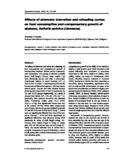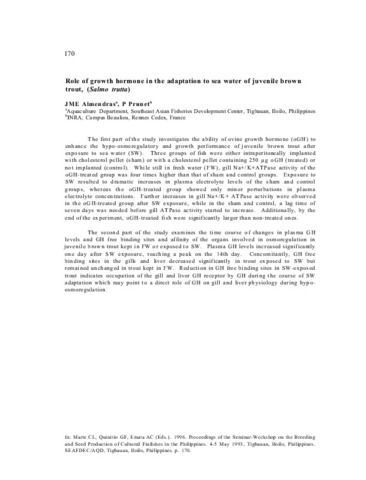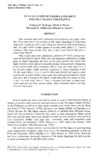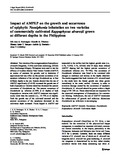Effects of alternate starvation and refeeding cycles on food consumption and compensatory growth of abalone, Haliotis asinina (Linnaeus).

View/
Request this document
Date
2002Author
Page views
197Metadata
Show full item recordCited times in Scopus
Share
Abstract
The effects of alternate starvation and refeeding on food consumption and compensatory growth of hatchery-bred abalone, Haliotis asinina (Linnaeus), were determined. Two groups of abalone juveniles (mean shell length = 29 mm, body weight = 5 g) were alternately starved and refed a macro-alga, Gracilariopsis bailinae at equal duration (5/5 or 10/10) over 140 days. A control group (FR) was fed the seaweed ad libitum throughout a 200-day experimental period. Starved and refed abalone showed slower growth rates (DGR, 63 and 70 mg/day in the 5/5 and 10/10 groups respectively), as a result of reduced food intake (DFI 15% and 16% day−1 respectively), after repeated starvation and refeeding cycles. Percentage weight gains (5/5 = 196%, 10/10 = 177%) were significantly lower than that of the control (397%). When refed continuously over 60 days, the starved groups exhibited increased DFI and fed at the rate of 24% and 25% day−1, which were not significantly different from that of the control at 26% day−1. At the end of the experiment, no significant differences were observed among three treatments in terms of shell length (range: 46–48 mm), body weight (range 25–28 g), % weight gain (392–465%) and per cent survival (range 87–98%). The results indicated that H. asinina had a complete compensatory growth following a return to full rations after a series of intermittent starvation and refeeding cycles.
Suggested Citation
Fermin, A. C. (2002). Effects of alternate starvation and refeeding cycles on food consumption and compensatory growth of abalone, Haliotis asinina (Linnaeus). Aquaculture Research , 33(3), 197-202. https://doi.org/10.1046/j.1365-2109.2002.00656.x
Subject
Collections
- AQD Journal Articles [1222]
Related items
Showing items related by title, author, creator and subject.
-
Role of growth hormone in the adaptation to sea water of juveline brown trout, (Salmo trutta)
Almendras, J. M. E.; Punet, P. (Aquaculture Department, Southeast Asian Fisheries Development Center, 1996)The first part of the study investigates the ability of ovine growth hormone (oGH) to enhance the hypo-osmoregulatory and growth performance of juvenile brown trout after exposure to sea water (SW). Three groups of fish ... -
An evaluation of formulated diets for Nile tilapia fingerlings
Santiago, Corazon B.; Reyes, Ofelia S.; Aldaba, Mercedes B.; Laron, Manuel A. (Fisheries Research Society of the Philippines, 1986)Nine practical diets were formulated and prepared as dry pellet crumbles. These were fed to two batches of Nile tilapia fingerlings (0.753g initial mean body weigt for trial I, and 0.961g for trial II) at 10% of fish biomass ... -
Impact of AMPEP on the growth and occurrence of epiphytic Neosiphonia infestation on two varieties of commercially cultivated Kappaphycus alvarezii grown at different depths in the Philippines
Borlongan, Iris Ann G.; Tibubos, Keneth R.; Yunque, Dianne Aster T.; Hurtado, Anicia Q.; Critchley, Alan T. (Springer, 2011)Two varieties of the carrageenophyte Kappaphycus alvarezii (Tungawan, TUNG; and Giant tambalang, GTAM) from Zamboanga Sibugay, Philippines were used to test the efficacy of Acadian Marine Plant Extract Powder (AMPEP) as ...




